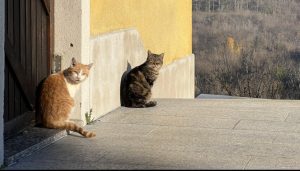During our 12 days in Split, we used the time to catch up on some personal priorities. Due to the seasonal slowdown and the marginal weather, we opted not to make any daytrips to Croatia’s numerous island destinations or to Dubrovnik in the far southern corner of Croatia. Split is rich with atmosphere and we had a well-equipped apartment for cooking some meals on our own, so we focused on absorbing the local vibe. Our stay in Split also included the excitement of the unprecedented “World Cup at Christmas” and the Croatian wins over Japan and Brazil in the knockout stage. Unfortunately, on our last night in Split, Croatia was defeated by Argentina in the semi-finals match.
Split’s main attraction is the palace of the Diocletian who was a major figure in the waning years of the Roman empire. Born just a few miles from Split in the Roman town of Solin. He rose through the ranks as a military commander and became Caesar for 20 years. An effective ruler, he stabilized the empire enough to postpone the western empire’s fall for another century. He also created a system of co-emperors which set the conditions for dividing the empire the fall of Rome in the west. It also set the stage for a power struggle between successors which the emperor Constantine ultimately won. Diocletian is additionally known for being the first Caesar to abdicate and for being the last Caesar to persecute Christians. He was an outsized historical figure and, while in power, he ordered the construction of a magnificent palace near his hometown. Upon his abdication he retired to that palace in Split to live out his remaining days near his home.
That palace was also a fortress. In the chaotic centuries that followed with successive invasions fo Germanic tribes from the north and then the Ottomans from the east, the citizens of Solin moved inside the ruins of the palace after their town was destroyed, thus transforming Diocletian’s palace into a community, which evolved and grew into the town of Split. Today, Split is the second largest city in Croatia with 160,000 (a distant second behind Zagreb’s 750,000+).
Below is a portrayal of Diocletian’s Palace at its peak of its glory in the 4th century along with a modern aerial photo of modern Split (reverse angle). Our apartment was inside the rectangular perimeter of what was originally Diocletian’s, which is roughly located inside the blue circle. The thing that looks like a church in the center of the photo on the left was constructed with the purpose of becoming Diocletian’s mausoleum after his death. At 1,700 years old, it is among the best preserved examples of late Roman architecture and is still a functional building today. You can see it in the photo on the right next to the l (and much newer) church steeple. This complex together is today known as the Cathedral of St. Domnius.


Split is a city built in layers, beginning with modifications made by the original refugees from the destroyed town of Solin and continuing today as the needs of the city and the necessity of preservation demand constant work and re-construction. As you walk around the narrow streets of Split, it’s both fascinating and maddening to know exactly how old its constituent structures are, for what purpose they were originally built, and when they were modified. You can peel away these historical layers and still feel overwhelmed by the centuries of history ingrained in the city’s architecture.
It took 12 days but we finally got comfortable navigating the narrow “streets” and alleys of the historic district without getting lost, walking in circles, or surrendering to Google Maps.
We also took a couple longer walks and explored the large nature preserve and park just west of the city with terrific views of the Adriatic and the nearby island. Split is a major transportation hub for these islands with ferries coming and going almost constantly.
Split by Day
















Split at Sunset
Split is at 43.5° north latitude so we had short days in the final weeks of autumn. The sun was coming up around 7:15 a.m. and setting around 4:30 p.m. The winter atmospherics made for some great sunsets during our afternoon walks.
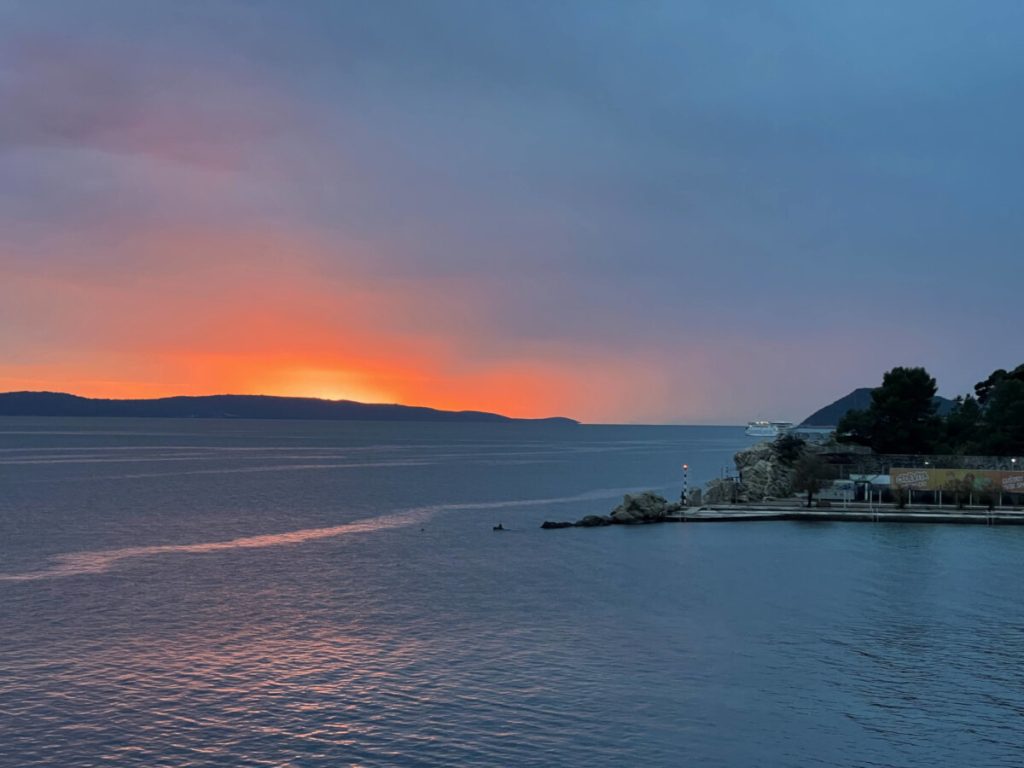





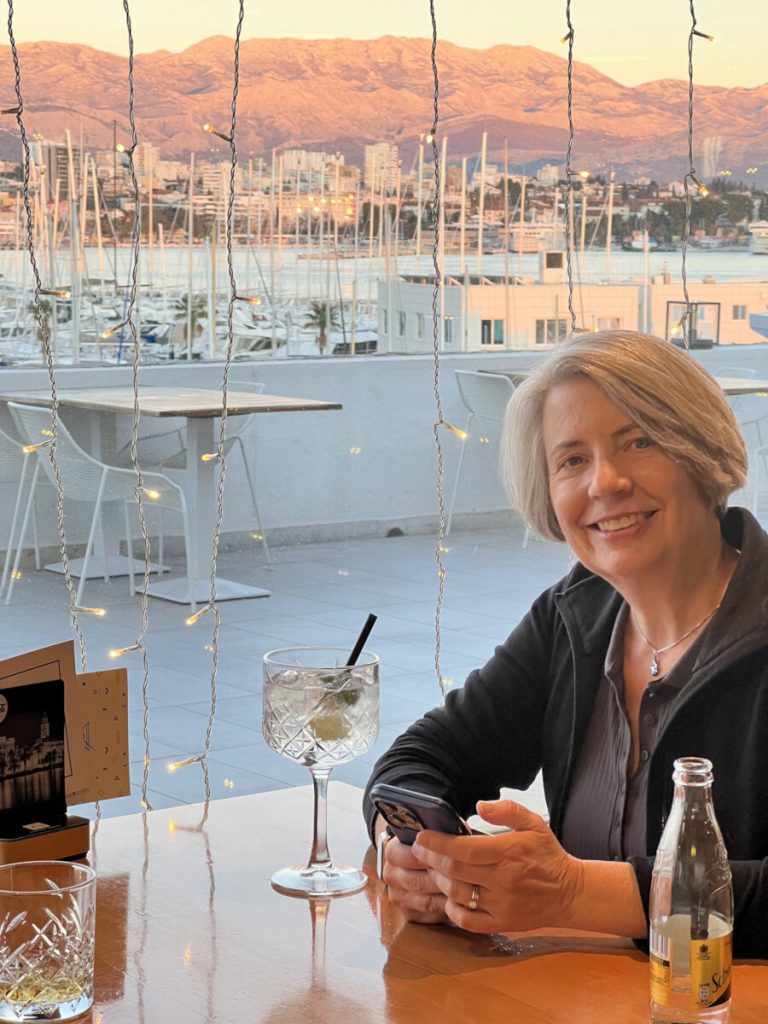













Split by Night




















Trogir
The only time we left Split was for an afternoon trip to the town of Trogir laying just 12 miles west at the other end of the bay where Split sits. We had blue skies and lovely weather for a few hours while we walked the town and had lunch. Then dark clouds rolled over the mountains to the north, the sky went black, and then the heavens opened with hail and a cold rain pouring down. Thankfully, we scurried to the bus station and found shelter just in time.








The U.S. Navy in Split
The train station, bus station, and ferry terminal are co-located at the edge or Split’s harbor. When we got off the bus from Zadar, one of the first things we saw was a U.S. Navy guided missile destroyer moored at the ferry piers. This brought back some great memories because my last visit to Split was during my Executive Officer tour on USS CARTER HALL back in May of 2006. The crew had a terrific visit to Split back then, which was one of the reasons I wanted Lyn to see this city. I was also excited to find out which ship this was and to run into Sailors on liberty,
After checking into our apartment, we took a walk up the hill to an overlooking panoramic view of the city. This is where we saw the destroyer leaving Split harbor and sailing into the sunset.
On our last full day in Split, we saw that an Expeditionary Fast Transport ship (T-EPF) of the U.S. Navy’s civilian-operated Military Sealift Command had pulled into port. These ships have very small crews compared to a destroyer and the civilian mariners blend into a crowd much more easily, so we did not casually encounter any crew members.




Hiking Marjan Park
On a day of clear weather, we hiked the peninsula just west of the city center, which has some development along the Adriatic coast but is otherwise a nature reserve called Marjan Park. A rugged hill straddles the center of the peninsula. At the top of the hills, we found an overlook where you could simultaneously see both the Adriatic to the south and the protected bay to the north.




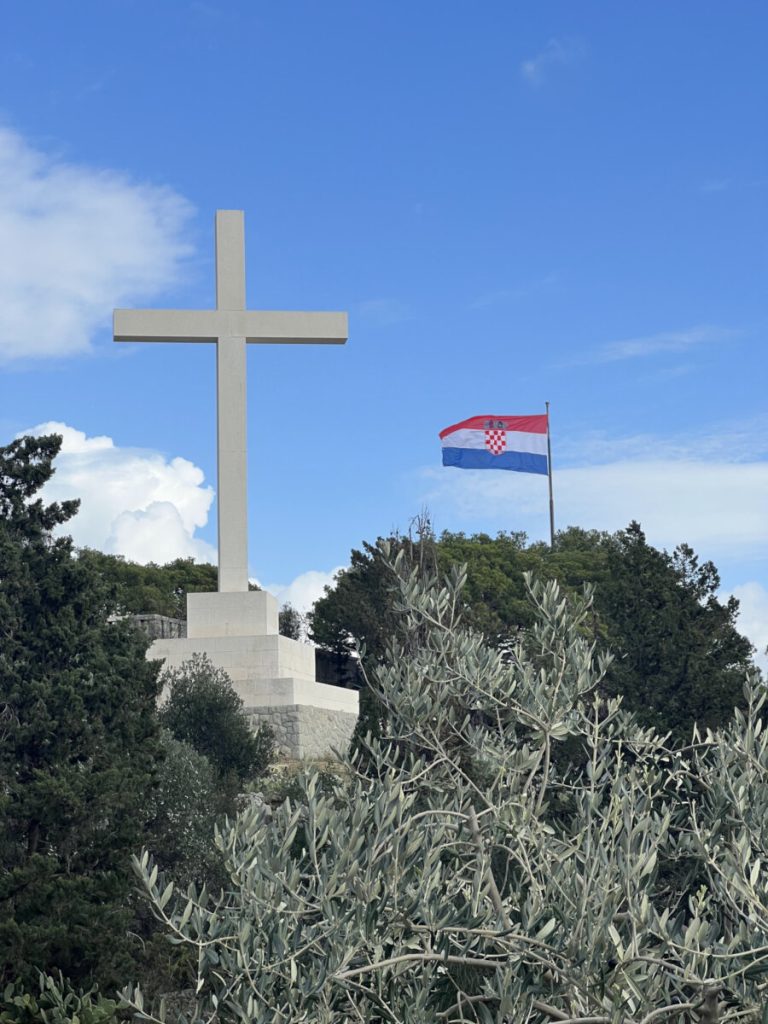



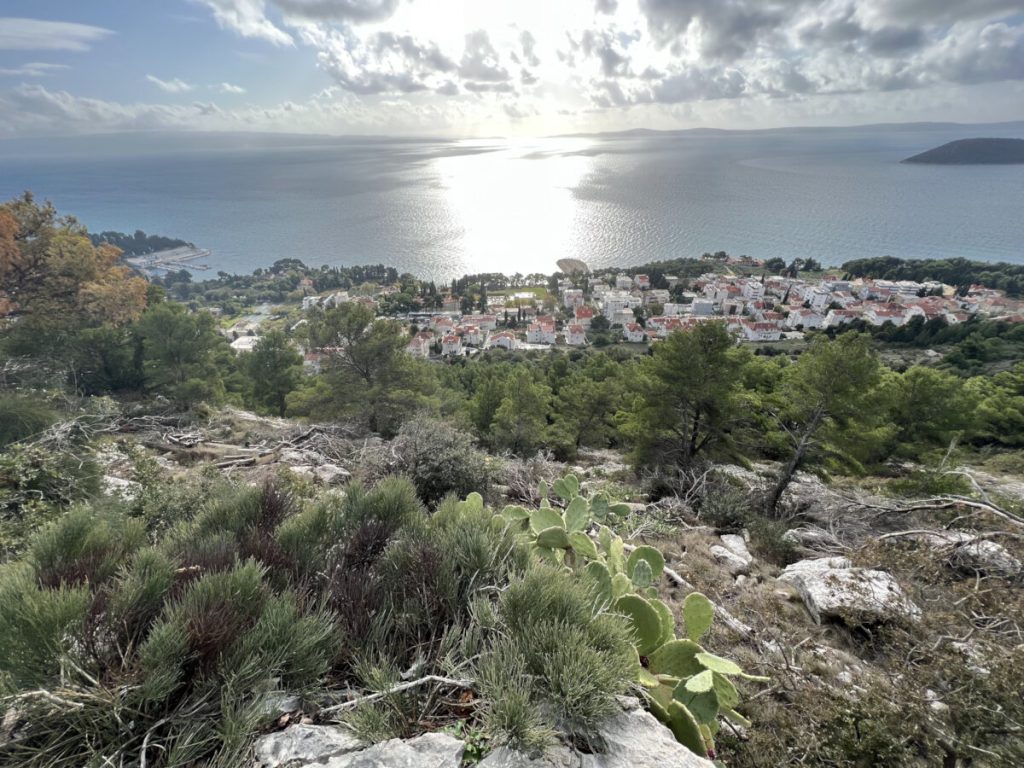



Diocletian’s Palace
We didn’t have a single day without walking on, passing through, or touching Diocletian’s Palace in some way. The ruins of it surrounded us. However, we visited two separate sections of the palace that required paid entry. The first was the palace’s subterranean labyrinth of arches, cisterns, supports, and passageways. Most of this area had been filled solid with trash from centuries of townspeople living inside the walls of the ruins. The removal of trash and systematic mapping of the palace understructure didn’t happen until after World War 2.
In one sense, it’s just a big empty basement and not a whole lot to see. In another sense, it’s architectural mastery still standing after 1,700 years. My dad would have loved it. My mom not so much.
In the center of the palace was a passageway used for linking the four quadrants together and for the palace security to escort visitors who arrived by boat at the palace’s waterfront. Today, this passageway is open to the public and houses a series of kiosks selling souvenirs, artwork, and clothing geared toward tourists. This passageway is also a thoroughfare to get from the waterfront promenade to the interior of the historic area. What we figured out after doing the paid admission to the sub-terranean structures is that everything you would want to see and appreciate is visible in the public space. The rest of the spaces are just more of the same thing. To appreciate the massive scale of the palace, it helps to pay the admission fee, but otherwise you wouldn’t be missing much and can spend your money on a souvenir instead.








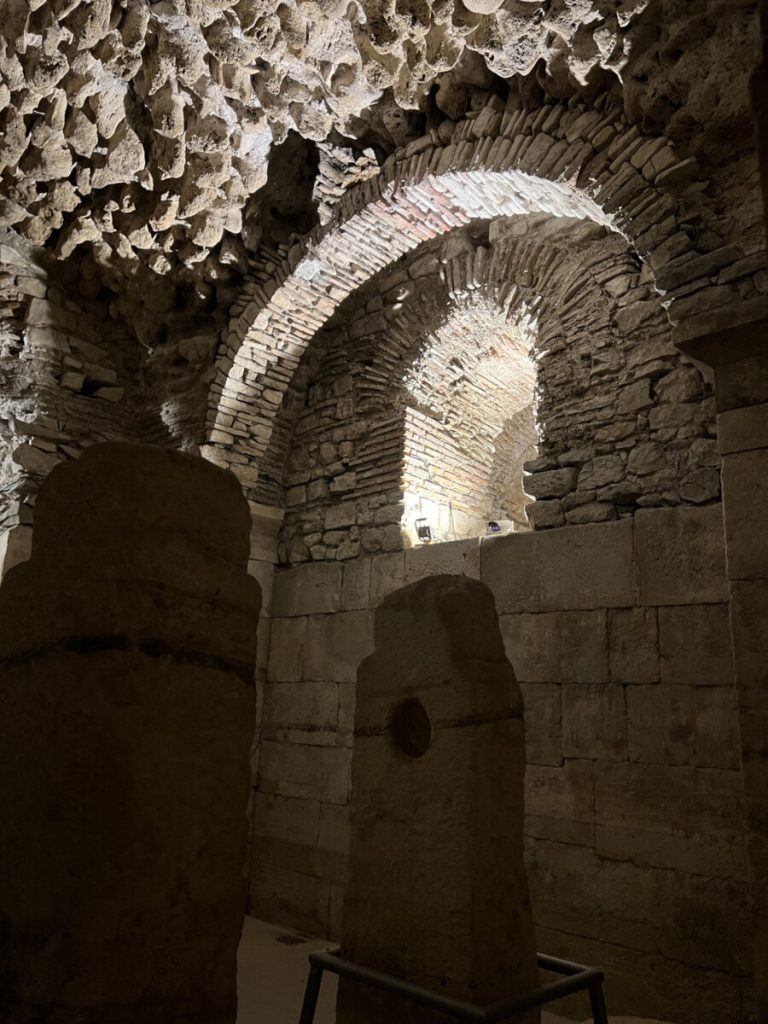

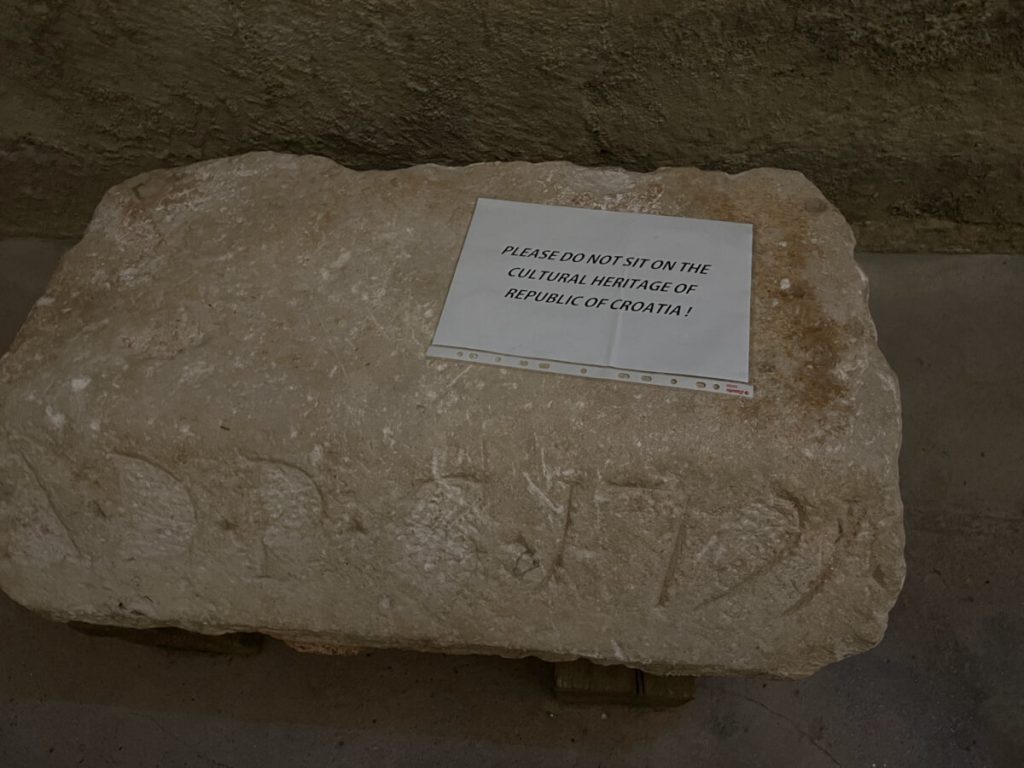



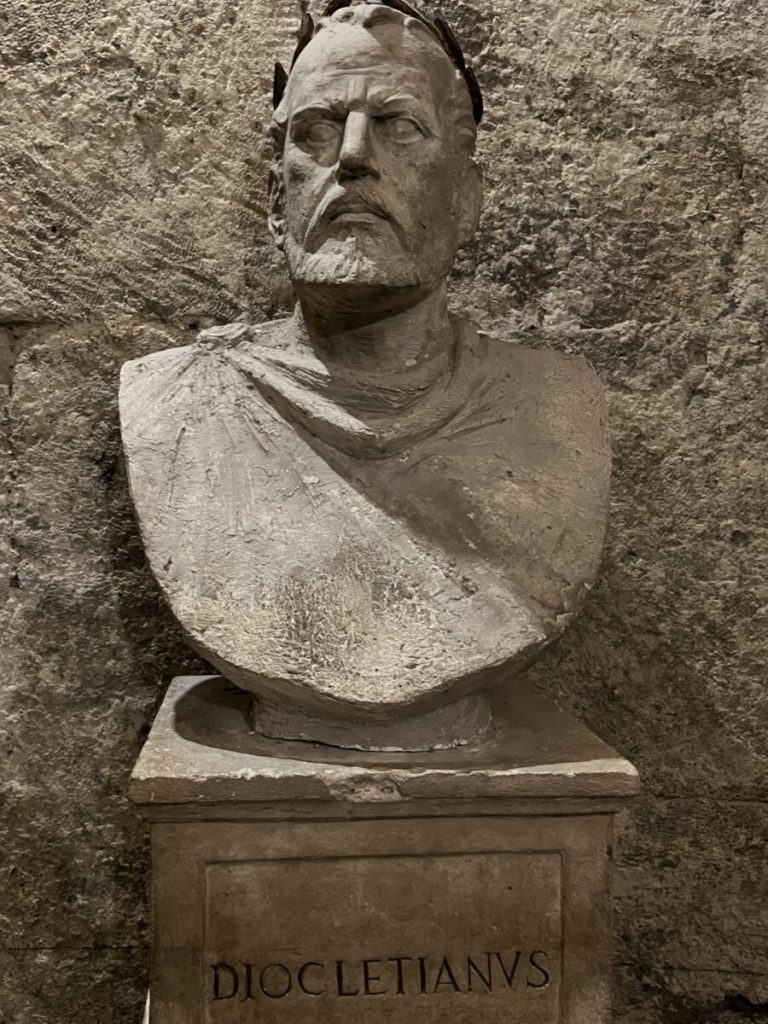

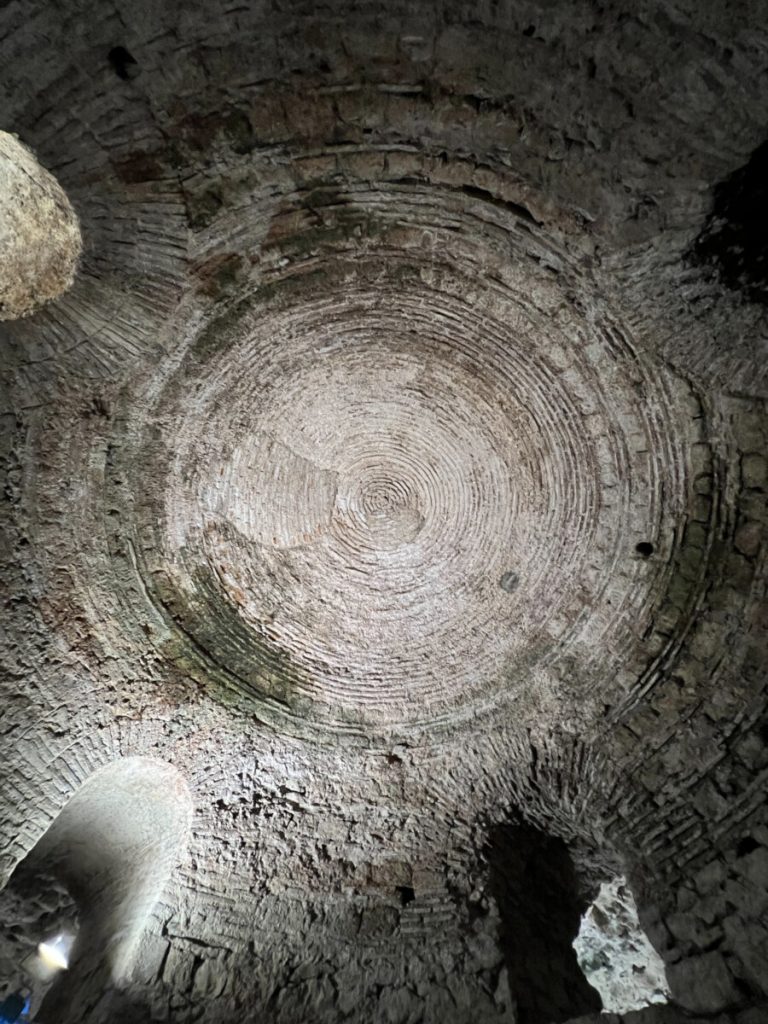

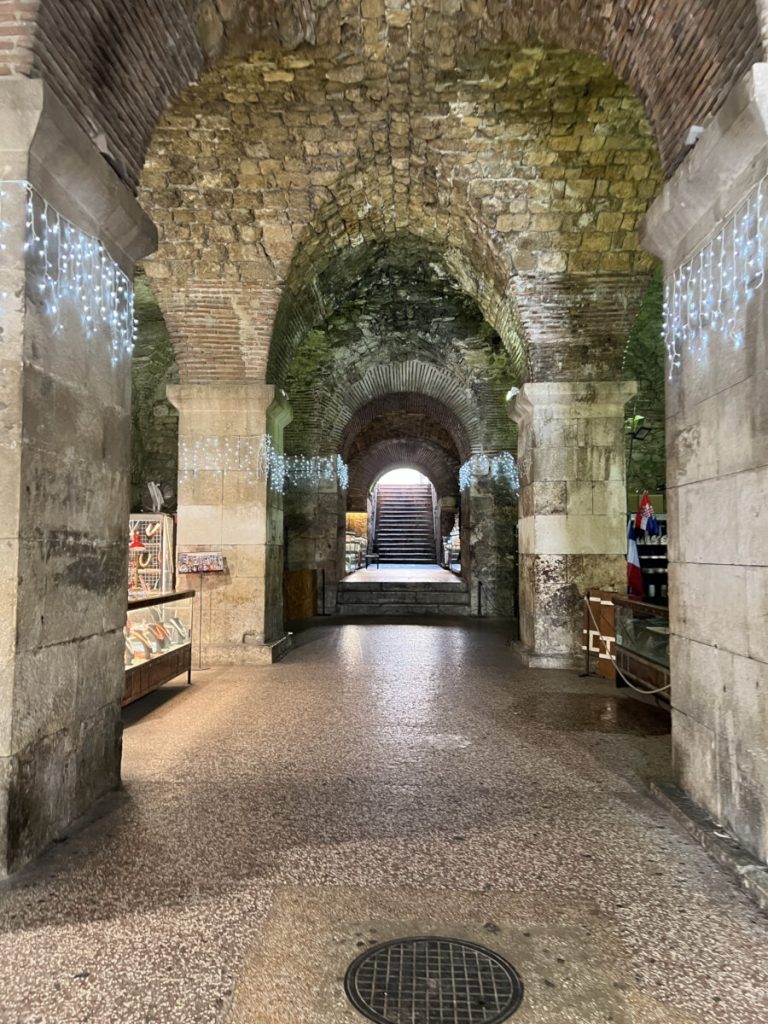

On the main level of the palace, some of the original walls and structures remain intact, including a space that once was domed but now is open to the weather. The last photo below is the belltower of St. Domnius viewed through one of the openings in the eastern wall of the palace.








You can also enjoy Diocletian’s Palace in your friendly neighborhood Spar grocery store. Just look for the columns between the produce section and the deli.
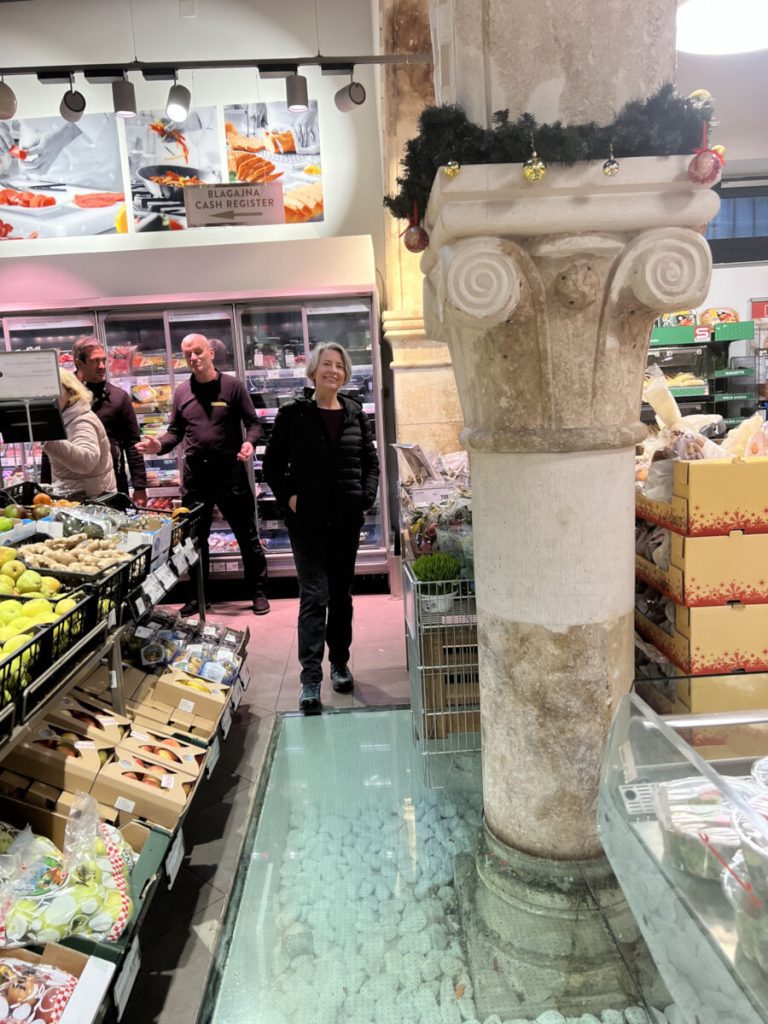

St. Domnius and Diocletian’s Mausoleum
Although Diocletian’s mausoleum is still intact, it was converted into a Catholic church and remains so today as the Cathedral of St. Domnius. Not everything inside it is original Roman construction but its walls and much of the stonework are. You can see carvings of Roman chariots around the top of the circular opening of the dome. The church also displays the original Roman mosaic beneath a floor installed when the building was converted into a church. The sphynx in the second picture is just outside the church; it was brought to Split by the Romans when the palace was built in the late 200s and was then already over a 1,000 years old. Considering Diocletian’s intense persecution of Christians, it is perhaps a degree of karmic justice that his mausoleum is now a cathedral. In the final photo, a couple was having their wedding picture taken outside the cathedral.
















World Cup 2022
Back in August and September, I vaguely remember people talking about World Cup qualifier games and I remember thinking “seems kind of early for people to be getting excited about an event that won’t happen until next summer.” Yes, I was aware that Qatar was hosting the next World Cup. Yes, I am aware the summer weather in Qatar is lethally hot. But no, I wasn’t tracking the major news even that World Cup 2022 would be played in November-December. I also could not have told you that I knew Croatia lost in the final game of World Cup 2018 against France. I don’t dislike soccer but most of my interest in World Cup 2018 ended when the U.S. was eliminated.
As they say, it’s better to be lucky than good so we have been extremely lucky our visit coincided with another fantastic performance by the Croatian national team. We’ve had a blast watching them succeed and advance.
We arrived in Split on Friday, Dec 2nd. Our timing was perfect to see Croatia win over Japan on Monday the 5th and then win over Brazil in the quarter final on Friday the 9th. We watched both of these games on a jumbo big screen TV in a town plaza decorated for the Advent season, including a Christmas tree and an ice rink. The Croatian wins during penalty kicks (both games) was a sporting moment to behold as the town went nuts, especially when they beat Brazil.
Our final night in Split was Tuesday the 13th. It was cold and raining that night, so we modified our strategy to watch the first half indoors and then go watch second half in the same plaza depending on how the game was going. Unfortunately, it wasn’t going well at halftime and never got better so we stayed in the restaurant and ordered another round of drinks for second half.
The best part about Croatian soccer victories is the rousing songs they start playing and singing after the match. I have no idea if they are nationalistic or just very hearty drinking songs, but everyone who speaks Croatian knows the words and they belt it out. Then there’s the fireworks and the couple nutjobs who light road flares and wave them around in the middle of a crowd.
The Advent markets in Europe are an experience on their own. The World Cup is an experience on its own. If you didn’t know we had no idea about FIFA holding the World Cup in the winter to accommdoate the Qatari climate, you might think we were geniuses. I assure you that’s not the case.


















Trivia sidebar: What three animals are on the Croatian Flag?
The five symbols at the top of the red and white checkered field represent the five historical regions of Croatia:
- Croatia proper (around Zagreb)
- Slavonia
- Istria
- Dalmatia
- Dubrovnik (a city with a special history)
Answer: The Istria crest shows a GOAT. The Dalmatian crest shows three LIONS (some sources say leopards but I think this is a translation problem). The Slavonian crest shows a PINE MARTEN which is kind of like a weasel of a fisher.
Croatian Flag for 500, Ken!
Up the Tower
We waited for good weather and finally climbed the bell tower of St. Domnius. It was good we waited because by that point we had walked the city enough to be very familiar with the stunning view from the tower. Our apartment was obscured by a slightly taller building by I marked its approximate location. We also got a good top-down view of the Temple of Jupiter, which is another extremely well-preserved Roman building but was not open for tourists in the off-season (last photo).
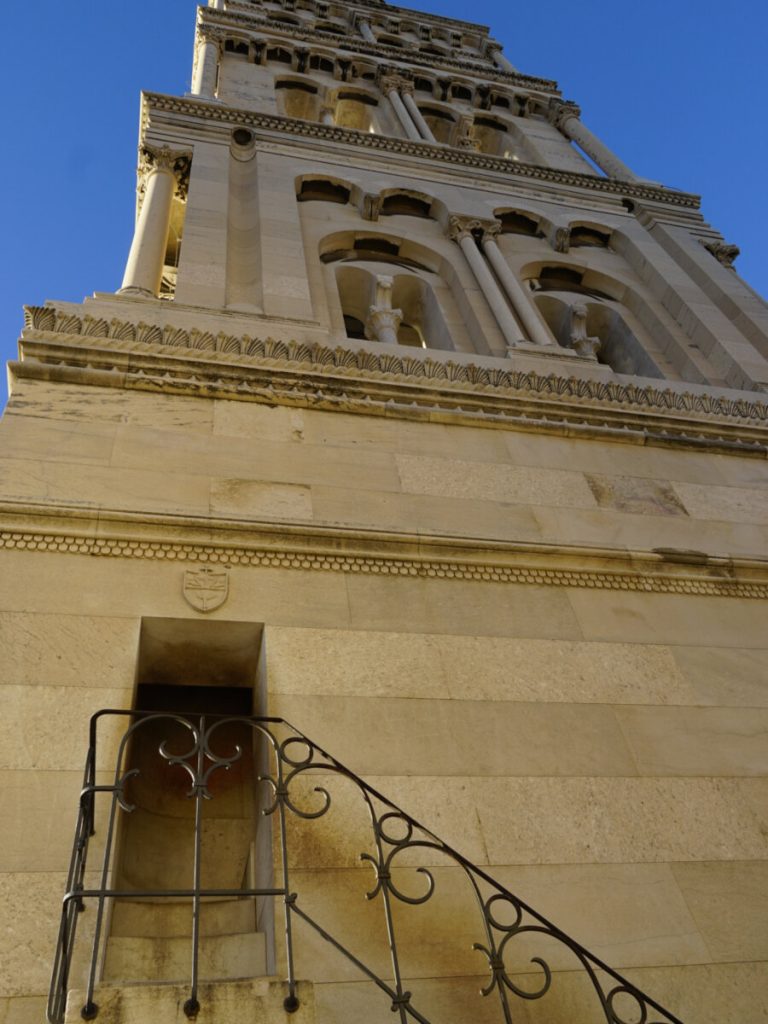









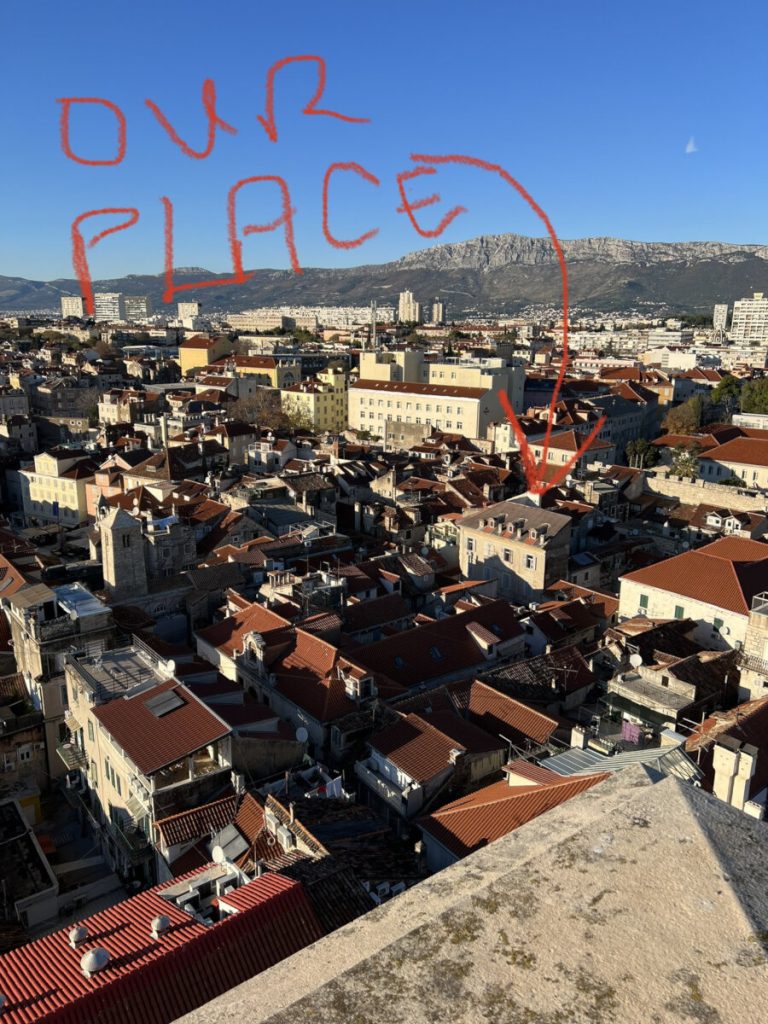





The Obligatory Museum
Our admission to the Cathedral of St. Domnius included its treasury collection, which had a lot of unique and beautiful works, including:
- Roman mosaics made with very small and shiny stones,
- a 15th century carved stone of St. John the Evangelist that was crafted from a 1st Century sarcophagus of a Roman woman patrician,
- relics from St. Cosmas and St. Damian stored inside a silver finger, and
- several books from the 7th and 8th centuries


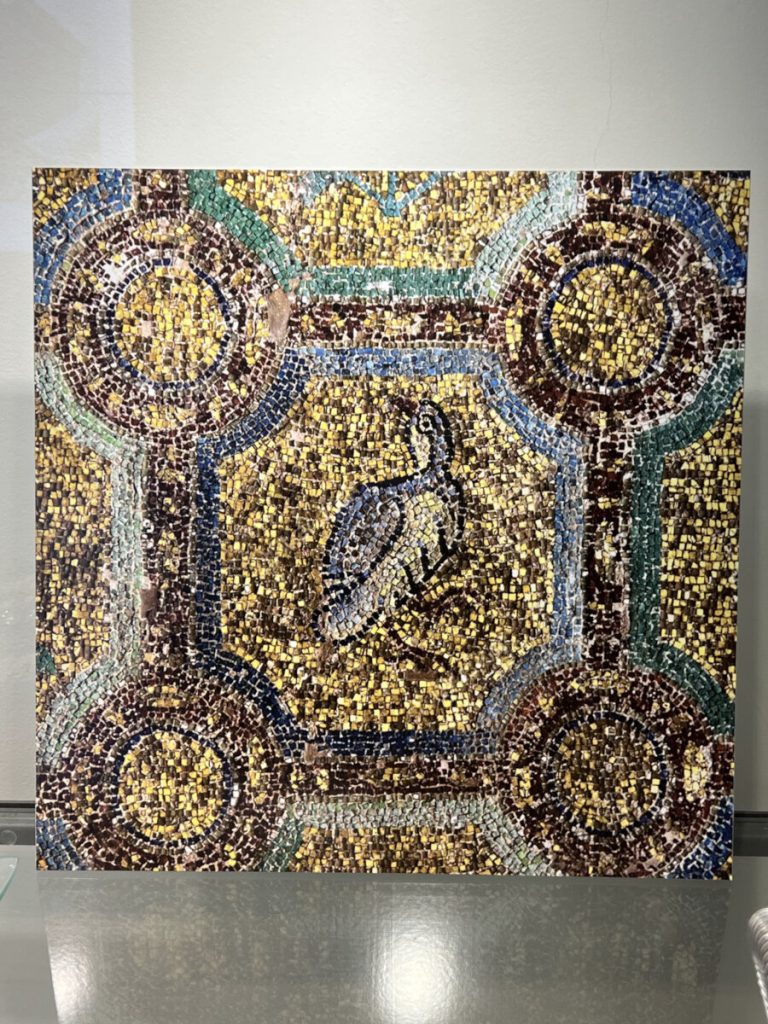







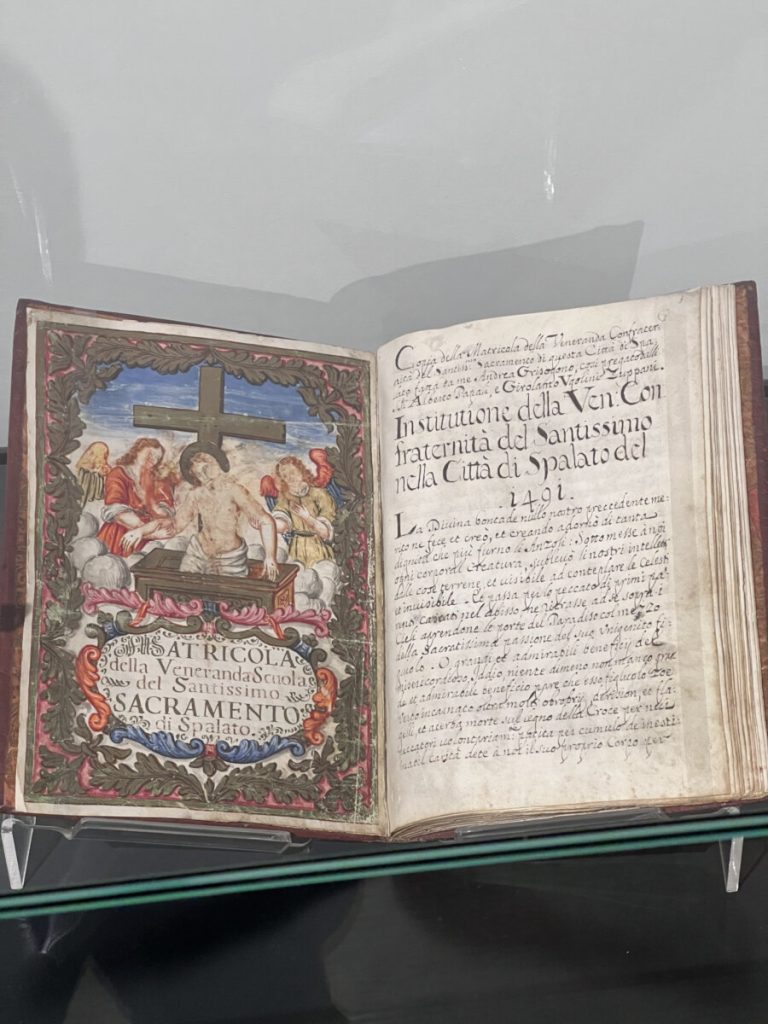

Advent in Split
The city was decorated for Advent and celebrations were in full swing. We enjoyed the lights, the music, the people it brought out, and the “kuhano vino” or cooked wine.






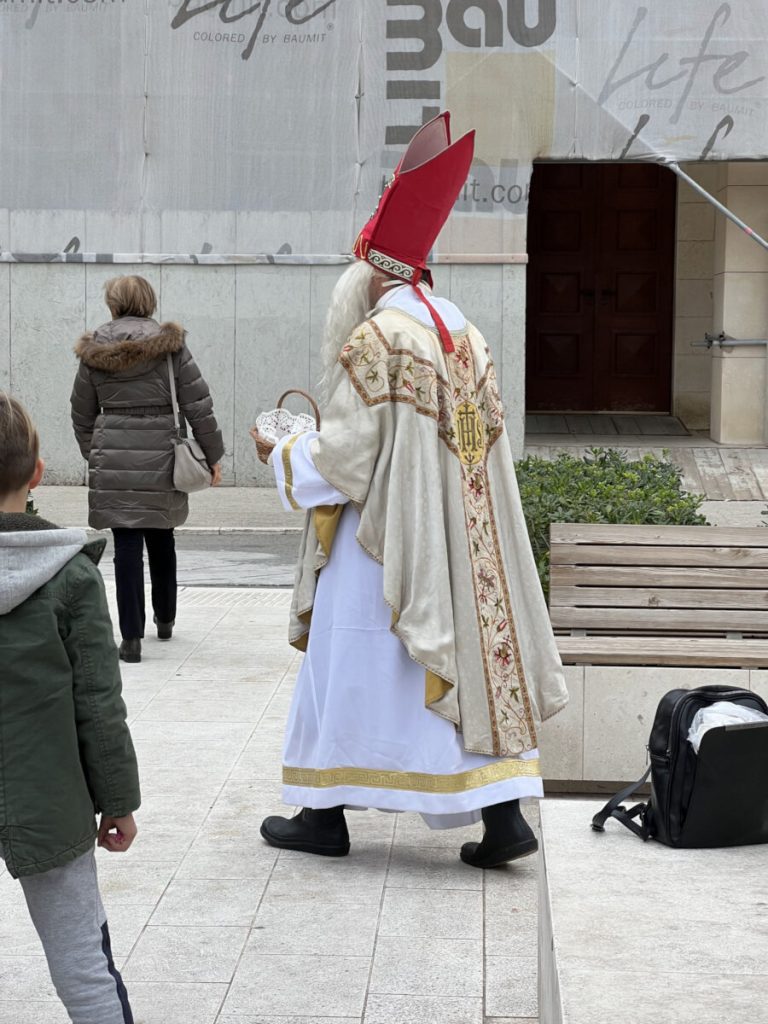









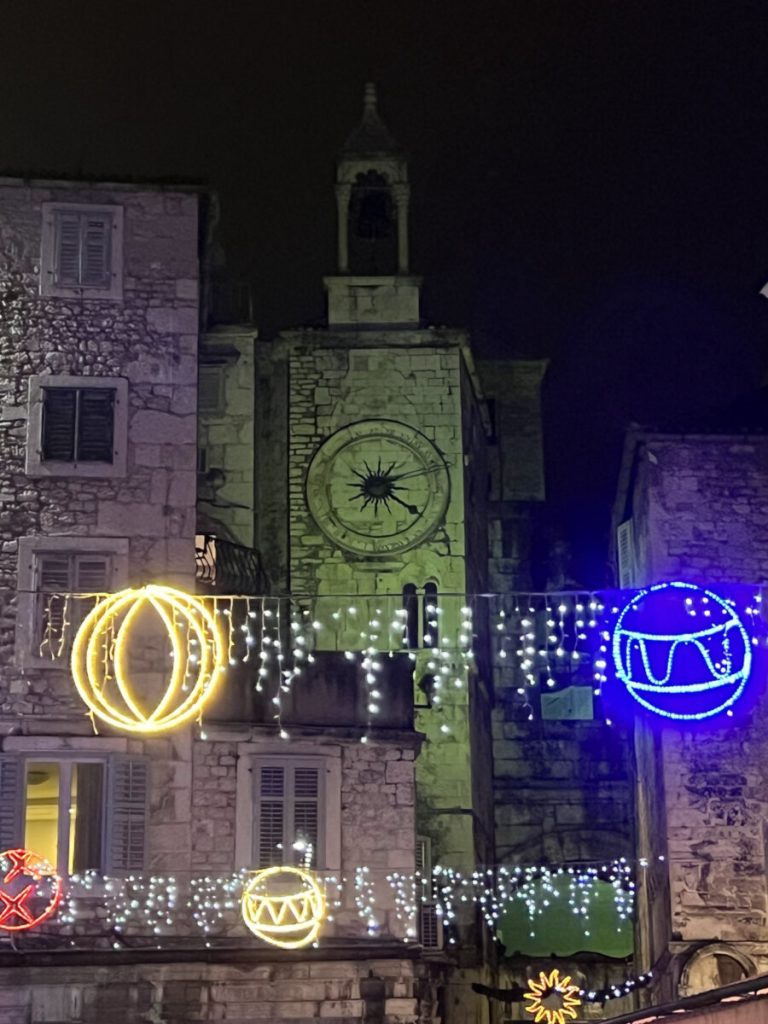



Time to make like a banana, and Split
My fist visit to Split in 2006 made a great first impression. In fact, I was even able to dig up a photo from that visit in front of St. Gregory of Nin, which is among the more striking statues we have seen during the past three months of travel. Here’s the photo (now and then). Digital cameras have come a long way in 16 years.





Split made a second great first impression in 2022. The city has changed far less than I have, but this visit also was much longer and my liberty buddy was way more attractive than my Navy shipmates in 2006. I loved Navy port visits but this is definitely a more relaxing way to see the world.
We left Split in the morning chill of December 14th, the morning after Croatia’s elimination from the World Cup, but the holiday spirit was undiminished even at 0900. We took one last walk through the narrow stone streets of Split with my rolling luggage thumping loudly. We boarded the bus and got one last look at Split as it rolled past our windows. Our memories will always be tinged with the warmth of the Advent season and the excitement of the World Cup.
The bus ride to Zagreb is five ours and will mark the final phase of our 32 days in Croatia and the five-day countdown to southern Spain where we are looking froward to meeting our three kids for Christmas and New Year.

